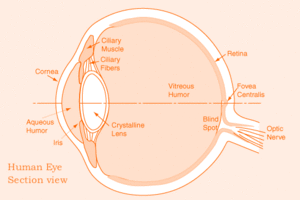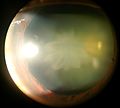Cataract facts for kids
A cataract is a clouding that develops in the crystalline lens of the eye or in its envelope, varying in degree from slight to complete opacity and obstructing the passage of light. Early in the development of age-related cataract the power of the lens may be increased, causing near-sightedness (myopia), and the gradual yellowing and opacification of the lens may reduce the perception of blue colours. Cataracts typically progress slowly to cause vision loss and are potentially blinding if untreated. The condition usually affects both the eyes, but almost always one eye is affected earlier than the other.
A senile cataract, occurring in the elderly, is characterized by an initial opacity in the lens, subsequent swelling of the lens and final shrinkage with complete loss of transparency. Moreover, with time the cataract cortex liquefies to form a milky white fluid in a Morgagnian cataract, which can cause severe inflammation if the lens capsule ruptures and leaks. Untreated, the cataract can cause phacomorphic glaucoma. Very advanced cataracts with weak zonules are liable to dislocation anteriorly or posteriorly. Such spontaneous posterior dislocations (akin to the historical surgical procedure of couching) in ancient times were regarded as a blessing from the heavens, because some perception of light was restored in the cataractous patients.
Cataract derives from the Latin cataracta meaning "waterfall" and the Greek kataraktes and katarrhaktes, from katarassein meaning "to dash down" (kata-, "down"; arassein, "to strike, dash"). so it is also possible that the name came about through the sense of "obstruction". Early Persian physicians called the term nazul-i-ah, or "descent of the water"—vulgarised into waterfall disease or cataract—believing such blindness to be caused by an outpouring of corrupt humour into the eye. In dialect English a cataract is called a pearl, as in "pearl eye" and "pearl-eyed".
Contents
History
The earliest records are from the Bible as well as early Hindu records. Early cataract surgery was developed by the Indian surgeon, Sushruta (6th century BCE). The Indian tradition of cataract surgery was performed with a special tool called the Jabamukhi Salaka, a curved needle used to loosen the lens and push the cataract out of the field of vision. The eye would later be soaked with warm butter and then bandaged. Though this method was successful, Sushruta cautioned that it should only be used when necessary. Greek physicians and philosophers traveled to India where these surgeries were performed by physicians. The removal of cataract by surgery was also introduced into China from India.
The first references to cataract and its treatment in Ancient Rome are found in 29 CE in De Medicinae, the work of the Latin encyclopedist Aulus Cornelius Celsus. The Romans were pioneers in the health arena—particularly in the area of eye care.
The Iraqi ophthalmologist Ammar ibn Ali of Mosul performed the first extraction of cataracts through suction. He invented a hollow metallic syringe hypodermic needle, which he applied through the sclerotic and extracted the cataracts using suction. In his Choice of Eye Diseases, written circa 1000 CE, he wrote of his invention of the hypodermic needle and how he discovered the technique of cataract extraction while experimenting with it on a patient.
Signs and symptoms
As a cataract becomes more opaque, clear vision is compromised. A loss of visual acuity is noted. Contrast sensitivity is also lost, so that contours, shadows and color vision are less vivid. Veiling glare can be a problem as light is scattered by the cataract into the eye. The affected eye will have an absent red reflex. A contrast sensitivity test should be performed and if a loss in contrast sensitivity is demonstrated an eye specialist consultation is recommended.
In the developed world, particularly in high-risk groups such as diabetics, it may be advisable to seek medical opinion if a 'halo' is observed around street lights at night, especially if this phenomenon appears to be confined to one eye only.
The symptoms of cataracts are very similar to the symptoms of ocular citrosis.
Causes
Cataracts develop for a variety of reasons, including long-term exposure to ultraviolet light, exposure to radiation, secondary effects of diseases such as diabetes, hypertension and advanced age, or trauma (possibly much earlier); they are usually a result of denaturation of lens protein. Genetic factors are often a cause of congenital cataracts and positive family history may also play a role in predisposing someone to cataracts at an earlier age, a phenomenon of "anticipation" in pre-senile cataracts. Cataracts may also be produced by eye injury or physical trauma. A study among Icelandair pilots showed commercial airline pilots are three times more likely to develop cataracts than people with non-flying jobs. This is thought to be caused by excessive exposure to radiation coming from outer space. Cataracts are also unusually common in persons exposed to infrared radiation, such as glassblowers who suffer from "exfoliation syndrome". Exposure to microwave radiation can cause cataracts. Atopic or allergic conditions are also known to quicken the progression of cataracts, especially in children.
Cataracts may be partial or complete, stationary or progressive, hard or soft.
Prevention
Although cataracts have no scientifically proven prevention, it is sometimes said that wearing ultraviolet-protecting sunglasses may slow the development of cataracts. Regular intake of antioxidants (such as vitamin A, C and E) is theoretically helpful, but taking them as a supplement has been shown to have no benefit. The less well known antioxidant N-acetylcarnosine has been shown in randomized controlled clinical trials to treat cataracts, and can be expected to prevent their formation by similar mechanisms. N-acetylcarnosine is a proposed treatment for other ocular disorders that are instigated, or exacerbated by oxidative stress including glaucoma, retinal degeneration, corneal disordes, and ocular inflammation.
Investigational Treatments
In the past few years, eye drops containing acetyl-carnosine have been used by several thousands cataract patients across the world. The drops are believed to work by reducing oxidation and glycation damage in the lens, particularly reducing cristallin cross-linking. Randomized controlled trials indicate the drops may be especially appropriate for seniors, or others where surgery is not advised.
Images for kids
See also
 In Spanish: Catarata para niños
In Spanish: Catarata para niños







